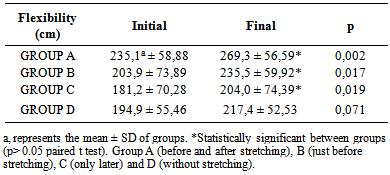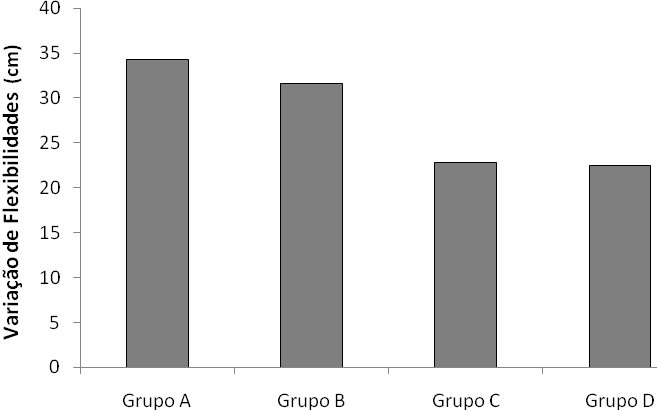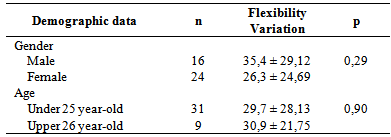-
Paper Information
- Next Paper
- Previous Paper
- Paper Submission
-
Journal Information
- About This Journal
- Editorial Board
- Current Issue
- Archive
- Author Guidelines
- Contact Us
International Journal of Sports Science
p-ISSN: 2169-8759 e-ISSN: 2169-8791
2014; 4(2): 67-71
doi:10.5923/j.sports.20140402.05
Evaluation of Passive Stretching in the Hamstrings Flexibility of Who Practice Exercises
Luana Torres Monteiro Melo1, Renata dos Santos Vasconcelos2, Lísia Maria Santiago Andrade Teles3, Larissa Mota Porto3, Julyana Almeida Maia4, Ana Paula Vasconcellos Abdon5
1PhD student in Biotechnology at the State University of Ceara, Fortaleza, Ceara, Brazil
2Master of Medical Sciences from Federal University of Ceara, Fortaleza, Ceara, Brazil
3Bachelor of Physiotherapy from University of Fortaleza, Fortaleza, Ceara, Brazil
4Master of Public Health from University of Fortaleza, Fortaleza, Ceara, Brazil
5PhD of Biotechnology from State University of Ceara, Fortaleza, Ceara, Brazil
Correspondence to: Luana Torres Monteiro Melo, PhD student in Biotechnology at the State University of Ceara, Fortaleza, Ceara, Brazil.
| Email: |  |
Copyright © 2014 Scientific & Academic Publishing. All Rights Reserved.
Objective: Does passive stretching before and after strength training effect the flexibility of the hamstrings in people who work out? Design: 40 healthy student volunteers, ranging in age from 18 to 35 years old, who work out were randomly divided into four groups, with group A stretching before and after working out, group B stretching just before working out, group C stretching only after working out, and group D abstaining from stretching. The hamstrings of each leg were stretched for 30 seconds. Results: A total of 40 students, of whom 24 (60.0%) were women with a mean age of 23.3 ± 4.18 years, were included in the study. Of that group, 34 (85.0%) had done physical activity at another time. Their workout regimens were aimed at weight loss (n =12/30, 0%), muscle gain (n = 25/62, 5%) and health maintenance (n = 3/7, 5%). The groups that engaged in stretching (A, B and C) experienced a significant increase in hamstring flexibility in the final evaluation (p <0.05), as compared to the group D. This study did not find any variation in flexibility between the groups (p> 0.05). Conclusion: Passive stretching resulted in increased hamstring flexibility, most notably in group A, which stretched the hamstrings before and after workout.
Keywords: Muscle Stretching Exercises, Joint Range of Motion, Resistance Training, Physical Therapy
Cite this paper: Luana Torres Monteiro Melo, Renata dos Santos Vasconcelos, Lísia Maria Santiago Andrade Teles, Larissa Mota Porto, Julyana Almeida Maia, Ana Paula Vasconcellos Abdon, Evaluation of Passive Stretching in the Hamstrings Flexibility of Who Practice Exercises, International Journal of Sports Science, Vol. 4 No. 2, 2014, pp. 67-71. doi: 10.5923/j.sports.20140402.05.
Article Outline
1. Introduction
- The practice of regular physical activity contributes to a more active lifestyle, is related to voluntary human behavior, and is determined by biological, psychological, sociological and cultural aspects [1, 2].Many exercises can be used in sports and therapeutic environments for increasing flexibility, enhancing the performance of individuals, and rehabilitating athletes and sedentary people [3, 4].Flexibility is an important component of physical conditioning programs as an adjunct to muscle strength and endurance training. A shortened muscle may create imbalance at joints and faulty postural alignment that may lead to injury and joint dysfunction. The hamstring muscles are an example of a muscle group that has a tendency to shorten and this reduced extensibility of the hamstrings could be associated with several clinical conditions of interest [5, 6].Among these, muscle stretching is a type of exercise that tenses the soft tissue structures to enable greater mobility, leading to an increase in joint range of motion and flexibility. Besides reducing muscle tension, muscle stretching can help maintain satisfactory levels of mobility in joints [7, 8].Among the various ways to stretch are: prolonged relaxation, dynamic or ballistic stretching and passive (static) stretching. Passive stretching is the safest and most commonly used form of stretching [8, 9].The acute effect of passive stretching allows the excitability reduction of alpha motor neuron for low-speed, creating better adaptations of muscle and connective tissue, and promoting their mechanical properties [9].When performed incorrectly, passive stretching can be a major cause of movement deficits. However, when done properly, it protects the joints and muscles, as it improves blood supply and keeps them healthy [10, 11]. There are still questions surrounding the true influence of stretching and the ideal times to utilize it in relation to the functional performance of individuals, regardless of athletic ability.Currently, passive stretching before exercises that require effort is not being done because the short duration may cause decreased muscle strength [5, 11]. Instead, it has been recommended after physical activity, as it contributes to the maintenance of muscle-tendon flexibility [5, 12]. Static stretching may not prevent injuries from high energy exercise, Potential high energy exercise injuries include fractures, joint dislocation and tearing of joints. However, static stretching can protect against injury sustained from low energy exercises, such as muscle strain, and it can reduce pain after exercise [13]. Moreover, there are studies showing that stretching before or after exercise has a direct effect on muscle soreness. However, this is a controversial topic among health professionals [12].The present study aimed to analyze the influence of passive stretching before and after strength training on hamstring flexibility in people who workout at the gym.
2. Methods
2.1. Design
- We conducted an interventionist, controlled, single blinded study developed at the Núcleo de Atenção Médica Integrada (NAMI), at the University of Fortaleza (UNIFOR), from December 2011 to March 2012.
2.2. Participants, Therapists, Centers
- The sample consisted of 40 students who visited the gym regularly for 1 to 5 months. The subjects ranged in age from 18 to 35 years, and had no history of chronic disease or musculoskeletal injury.This research adhered to the bioethical principles contained in Resolution 196/96 of the National Health Council [14], which regulates the ethical-legal aspects of research on humans. The research was approved by the Ethics Committee of UNIFOR according to opinion n° 294/2010. Before starting the study all participants were informed about the objectives, benefits, and risks included in the terms of consent.
2.3. Intervention
- After selection, the participants went through an initial assessment to collect the following information: identification, amount and type of physical activity, and sit and reach test scores using the Wells bench.The Wells bench was used to assess the flexibility of the hamstring muscle. In this test, a person sits on a mat, with the soles of both feet maintaining contact with a box. The top of the box has an indicator marked in centimeters that is used to measure flexibility by how far the person can push the indicator without bending the legs. The knees of the seated person are extended while the hips are flexed. The subject is then asked to take a deep breath, and during exhalation, flex the trunk forward with the upper limbs extended. The upper limbs are supported by a bench of 23 cm long aligned with a tape measure over the bench. During flexion of the trunk, the right hand is placed over the left and the tips of the fingers touch the indicator on top, and move it forward as far as possible.
2.4. Outcome Measures
- After evaluation, the participants were randomly divided into four groups: A, B, C and D. Group A. stretched before and after workout ; group B stretched only before workout; group C stretched only after workout; and group D did not stretch at all.Passive stretching of the hamstrings was performed only once, lasting 30 seconds [15], and initiated on the right leg. Participants were in supine position with head, trunk and arms aligned along the body. The researcher remained ipsilateral to the subject´s leg being stretched and applied external force to the limit tolerated by the participant. The researcher performed a hip flexion, knee extension, and dorsiflexion of the ankle while the opposite leg remained extended on the ground.Different researchers, seeking to standardize and blind stages of the research, performed the assessments and stretching procedure.
2.5. Data Analysis
- The data were submitted for descriptive and inferential statistical analysis. To analyze the difference between the initial and final evaluations, the following tests were applied to each group: analysis of variance test (ANOVA), the paired t test, and the Kolmogorov-Smirnov test of normality. In addition, the Statistical Package for the Social Sciences (SPSS) version 17.0 was used. The level of significance was set at 5% (p <0.05).
3. Results
- This study evaluated 40 students with a mean age of 23.3 ± 4.18 years, weight 67.1 ± 12.26 kg and height of 1.67 ± 0.90 meters. Of those evaluated, 24 (60%) were female and 34 (85%) had engaged in physical activity at another time. The purpose of working out, according to the participants, ranged from losing weight (n = 12/30,0%) to gaining muscle (n = 25/62,5%) and maintaining health (n = 3/7,5%).The effects of passive stretching on hamstring flexibility was assessed by comparing the final evaluation with the initial evaluation between groups. Group A (stretched before and after workout) experienced a significant increase in flexibility of 34.29cm (p = 0.002), group B (stretched only before workout) of 31.60 cm (p = 0.017) and group C (stretched only after workout) of 22.76 cm (p = 0.019). In group D, the variation in flexibility of 22.46 cm was not significant (p = 0.071) (Table 1).Did passive stretching before and after strength training effect flexibility among the participants in groups A, B and C? The influence of passive stretching on hamstring flexibility was assessed by comparing the final evaluation with the initial evaluation between groups. Group A experienced a significant increase in flexibility of 34.29 cm (p = 0.002); group B experienced an increase in flexibility of 31.60 cm (p = 0.017); and group C experienced an increase in flexibility of 22.76 cm (p = 0.019). In group D, the variation of flexibility of 22.46 cm was not significant (p = 0.071) (Table 1).
|
|
4. Discussion
- Several studies have been conducted with the objective of finding the optimal frequency and duration of stretching exercises [15, 16]. Also, there is a dearth of research linking these exercises with the best time to do stretch.This study did not find any variation in flexibility between the groups, demonstrating that performing a static stretch for 30 seconds – regardless of when the stretch is performed – helps to increase range of motion.In humans inadequate flexibility is a contributing factor to muscle injuries, particularly the hamstrings [17]. When stretching, a reduction of muscle strength due to increased viscoelasticity of the motor unit resulting in increased muscle length and can prevent injuries if performed consistently before and after exercise programs [18, 19, 20].However, there is disagreement on this issue as existing research shows that muscle strength is reduced when stretching is performed. This is due to neural and mechanical factors such as decreased activation of motor units, changes in the viscoelastic properties of the muscle and musculotendinous, and changes in the length-tension of the muscle fiber [21, 22, 23].Other research shows that the effectiveness of stretching is due more to changes in the individual's tolerance to stretching than to changes in the elasticity of the muscles. They also claim that stretching does not make the hamstrings more or less rigid, but only influences tolerance to stretching [24, 25]. Some factors such as gender, age and biological individuality, influence flexibility [26]. Variations such as the female hormonal cycle, serum estradiol, or menstrual phase influence muscle flexibility [27, 28]. However, in this study, age and sex did not influence the increase in range of motion.Studies also reveal that in relation to sex, women have greater flexibility as compared to men [29, 30]. However, other authors claim that women tend to have greater body composition, which is a factor that can negatively influence flexibility [31].The results of this study may contribute to health professionals working in clinical practice and scientific research in determining the best moment to stretch when engaging in physical activity, as there is a lack of reliable references on the effects of stretching on the flexibility of people who work out regularly.
5. Conclusions
- The data showed that passive stretching resulted in an increase in flexibility in the hamstrings of individuals who worked out particularly those who stretched before and after workout.
 Abstract
Abstract Reference
Reference Full-Text PDF
Full-Text PDF Full-text HTML
Full-text HTML

